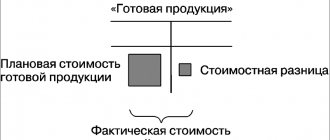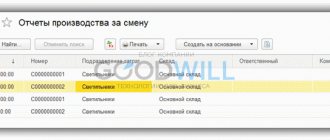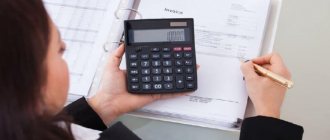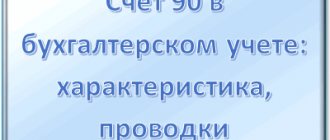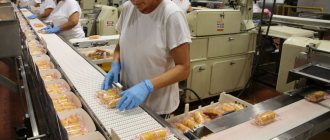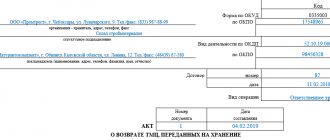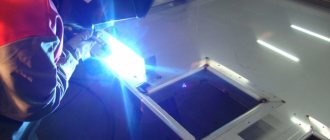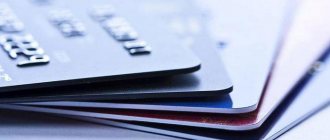Currently watching: 961
Accounting for finished products in production is carried out on account 43 “Finished products”.
Finished products are assessed according to:
– actual production cost – the sum of all costs associated with the manufacture of products (collected in full only on account 20 “Main production”);
– according to standard (planned) cost - where deviations of the actual production cost for the reporting month from the planned (standard) cost are determined and separately taken into account.
Account 90 in accounting
The financial result from sales from the main activity is reflected on the account monthly. During the year, the account accumulates the financial result of the enterprise's main activities.
The movement pattern for the analytical subaccounts of account 90 is reflected in the table:
The main activity of the enterprise can be:
- sale of finished products and semi-finished products (own production);
- services of a non-productive or production nature;
- sale of purchased goods;
- construction, installation, research, geological exploration, etc.;
- rent;
- transport services;
- transportation of passengers;
- other.
Subaccounts of account 90
Closing a synthetic account is provided at the expense of your own analytical accounts. Some of them are active, some are passive. The difference between the active and passive balance is closed to account 90.09.
Sub-accounts can be opened for account 90:
- 90.1 - “Revenue”. The revenue subaccount reflects the amount of proceeds from sales. This is a passive subaccount;
- 90.2 - “Cost of sales”. Active subaccount reflects the cost of goods sold;
- 90.3 - “VAT on sales”. The VAT account is also active, in correspondence with account 68 it reflects the amount of VAT accrued to the budget;
- 90.4 - “Excise taxes”. The active excise subaccount reflects excise taxes included in the amount of goods sold;
- 90.9 - “Profit (loss) from sales.” The subaccount acts as a regulator; all other subaccounts are closed to it.
Typical correspondence for account 90:
Closing 90 accounts, postings
At the end of the month, the sales result is formed in subaccount 90.9. It happens like this:
- The balance is calculated for each subaccount.
- The total turnover for all subaccounts (debit and credit) is calculated, and the credit turnover is subtracted from the debit turnover. A positive balance means a loss, a negative balance means a profit.
- The financial result is reflected using account 90.9 and written off to account 99, in accordance with the accounting rules. Profit is reflected by posting Dt 90.9 - Kt 99.1, loss - Dt 99.1, Kt 90.9.
Thus, at the end of the month, each subaccount 90 has a balance, but there should be no balance on the synthetic account.
At the end of the year, each subaccount of account 90.x is closed to 90.9. Debit subaccounts are closed by posting Dt 90.9 - Kt 90.x, credit - Dt 90.x - Kt 90.9.
As a result, the balance of account 90 at the end of the year will be reset to zero. This process is part of the balance sheet reform carried out at the end of each year.
With the beginning of the new year, the account will be opened again, from scratch.
Analytical monitoring
The main purpose of using the 40th account in accounting is to evaluate data on the normative and actual SS, which is necessary for making appropriate management decisions designed to ensure the efficient use of the resources of any company.
Saved resources, when a credit balance remains on account 40 at the end of the reporting period, must be reversed by Dt 90 position. If there is a debit balance, i.e. there is an overexpenditure of resources, it is written off to the debit part 90 of the account.
Such a comparison of data is observed, as a rule, in those companies where there are a huge number of product groups, and therefore the assessment of indicators is carried out in the context of structural divisions or product names.
In conclusion, it must be added that the correct reflection of the costs of producing finished products in accounting records allows the company's management to make the right decision at the appropriate point in time, which will make it possible to make the enterprise's activities more efficient from an economic point of view.
What is account 90 used for in accounting?
To generate income, business entities incur expenses that must be taken into account in accounting in accordance with the current standards of PBU. To account for income and expenses from main activities, account 90 is used.
Here, information is summarized separately for each type of income and expense in chronological order. The main income is considered to be the revenue that comes to the company from the sale of products, goods, works, and services.
This account should reflect information about expenses that have already generated income for the company. It also takes into account indirect taxes, which are included in the price of products, works, and services. For example, VAT, excise taxes, etc.
At the end of each month, by comparing account turnover, the financial result is determined. If the excess on this account goes to the loan, then the company has received a positive result in the form of profit.
Sales of finished products through the distribution network
If a manufacturing company has its own distribution network, then the GP can be transferred for sale to a store or other outlet. Let's look at an example.
JSC Champion based on the results of November 2020:
- GP produced - 147 sets of sports equipment;
- actual costs for GP - 286,356 rubles;
- 54 sets of sports equipment were transferred for sale to Pobeditel’s own retail chain of stores;
- 93 sets of equipment were sold wholesale.
JSC "Champion" has set the price for GP:
- the cost of purchasing a set of sports equipment at retail is 3,250 rubles, VAT 496 rubles;
- Wholesale price of GP is 2,980 rubles, VAT 454 rubles.
Sales costs of the Pobeditel retail chain at the end of November 2020 amounted to 9,840 rubles.
The accountant of Champion JSC recorded the following entries in the accounting:
| Debit | Credit | Description | Sum | Document |
| 43 | 20 | A batch of sports equipment (147 sets * 1,948 rubles) arrived at the warehouse of Champion JSC | RUR 286,356 | Purchase Invoice |
| 43.1 | 43 | Part of the produced GP was transferred for sale to the Pobeditel TS (54 sets * 1,948 rubles) | RUR 105,195 | Sales Invoice |
| 62 | 90.1 | Part of the produced GP was sold in bulk (93 sets * 2,980 rub.) | RUR 277,140 | Packing list |
| 90.3 | 68.1 VAT | VAT on wholesale sales (RUB 277,140 * 18% / 118%) | RUR 42,276 | Invoice |
| 90.2 | 43 | The cost of sports equipment sold wholesale is written off as expenses (93 sets * 1,948 rubles) | RUR 181,164 | Costing |
| 90.9 | 99 | The amount of profit from the wholesale sale of inventory is taken into account (RUB 277,140 - RUB 42,276 - RUB 181,164) | 53,700 rub. | Turnover balance sheet |
| 50 | 90.1 | The amount of revenue from the sale of inventory through the Pobeditel chain of stores was taken into account (54 sets * 3,250 rubles) | 175,500 rub. | Implementation report |
| 90.3 | 68.1 VAT | VAT on sales through the Pobeditel vehicle (175,500 * 18% / 118%) | RUR 26,771 | Implementation report |
| 90.2 | 43.1 | The cost of sports equipment sold through the Pobeditel vehicle was written off as expenses (54 sets * 1,948 rubles) | RUR 105,192 | Costing |
| 90.2 | 44 | The operating expenses of the Pobeditel chain of stores were written off | RUR 9,840 | Expense report |
| 90.9 | 99 | The amount of profit from the sale of inventory through the Pobeditel vehicle was taken into account (RUB 175,500 - RUB 26,771 - RUB 105,192 - RUB 9,840) | RUR 33,697 | Turnover balance sheet |
Rate the quality of the article. We want to become better for you: If you have not found the answer to your question, then you can get an answer to your question by calling the numbers ⇓ Legal Consultation free Moscow, Moscow region call
One-click call St. Petersburg, Leningrad region call: +7 (812) 317-60-16
Call in one click From other regions of the Russian Federation, call
One-click call
Account 20 “Main production” - postings and examples
1 min
For institutions involved in the manufacture of products, performance of work and provision of services, it is extremely important to correctly reflect all costs in accounting. This is necessary to determine the cost of the product. That is why account 20 is one of the most important and indicative in accounting, because it aggregates all possible costs for the manufacture of products.
What is account 20 in accounting
Account 20 is one of the registers in Section III of the Chart of Accounts. It summarizes information about the costs associated with the production of products (works, services).
Expenses
The main function of account 20 “Main production” is calculation, since it describes the economic process of manufacturing a product and collects all information about the costs of its production. Also, using an account card, you can track information about the movement of property in the enterprise.
The difference between this register and the others in accounting is that its balance at the end of the reporting period is not calculated using a formula, but is entered manually. This is due to the fact that cost information is collected on the account over a period of time (at least a month). Until the end of the period, the exact cost of the goods is unknown, since it includes many components - depreciation, wages for workers and management, utilities, transportation costs.
Thus, at the end of the reporting period (and necessarily at the end of the year), the account. 20, like production shops, is subject to inventory to identify work in progress. After this, the amount spent on the production of finished products (actual cost) is calculated, which is written off using one of the methods adopted by the enterprise’s accounting policy.
What counts in the 20 count?
Account 20 is used to account for the following costs:
- production of products from agricultural and industrial enterprises, as well as subsidiary farms;
- costs of repair work, maintenance of cars and other vehicles;
- costs of organizations providing transport services;
- costs of construction, installation and design and survey work;
- costs of performing research and development work;
- costs of catering organizations;
- salaries of key and administrative personnel;
- depreciation of production equipment;
- amounts of payments for renting premises and paying for utilities;
- other expenses related to the activities of the production enterprise.
Debit 20 reflects all direct costs associated with the manufacture of products (performance of work and provision of services), costs of auxiliary production, indirect costs, as well as losses from defects. Credit 20 reflects the amount of the actual cost of goods, the production of which has already been completed, or work performed and services rendered.
Counting scheme 20
When determining the type of account 20 - whether it is active or passive - you need to understand the following: since the company cannot consume more raw materials and materials than it was written off for, therefore, debit turnover on the account. 20 will always be more credit. And this means that the count. 20 - active. Balance (remaining) according to account. 20 at the end of the month reflects the amount of work in progress costs.
How to close
Closing of account 20 occurs when the production of products is completed, work is performed or services are provided. To close the account, it is necessary to reflect it in the accounting entry for a loan for the amount of goods produced. Thus, after closing the account, it can either be reset to zero (if there are no other work in progress) or remain with a debit balance (if there is still work in progress).
Note! Account lending 20 does not always mean production is complete. If a defect is detected, it is also written off from credit 20 to debit 28 “Defects in production”.
Current legislation provides for the possibility of closing an account. 20 in one of three ways: direct, intermediate or direct implementation. The characteristics of the closing method must be spelled out in the accounting policy of the enterprise, and immediately before closing, the accountant must highlight the balances of work in progress, if any.
Direct method
This method is used when the actual price of manufactured products is unknown during the reporting period, so they are accounted for at conditional prices, mainly at planned costs. In the process of closing the account. 20 accounting department adjusts the cost of manufactured products to the actual cost.
With this closing method, accounting makes the following entries:
- Dt43 Kt20 - finished products are transferred to the warehouse at the planned cost;
- Dt90-02 Kt43 - writing off deviations of actual and planned cost to cost of sales.
Attention! When using this closing method, it becomes impossible to take into account the actual price of products during the month.
Intermediate method
When using this method, an account is additionally used in accounting. 40 “Product release”. This account reflects deviations of the planned cost from the actual one, while credit 40 includes the planned cost, and debit the actual cost.
Intermediate method of closing an account. 20
At the end of the reporting period, the total amount of the difference is written off proportionally to the account. 43 and 90-02. During the month, the accountant makes the following entries:
- Dt43 Kt40 - capitalization of finished products at planned cost;
- Dt90-02 Kt43 - write-off of sold products at planned cost.
How to close account 20 at the end of the month:
- Dt40 Kt20 - write-off of the actual cost of manufactured products;
- Dt43 Kt40 and Dt90-02 Kt40 are adjusting entries that bring the planned cost to the actual cost.
Direct implementation
This method of closing an account. 20 applies when the manufactured goods are not stored in a warehouse, but are immediately sold by the buyer. In this case, the costs are immediately written off to the cost of sales - Dt90-02 Kt20.
Subaccounts
For account 20 the following recommended sub-accounts can be opened for the main activities of the enterprise:
- 20-01 “Crop production”. This takes into account the costs of crop production and its branches - horticulture, floriculture, growing seedlings.
- 20-02 “Livestock” - accounting for the costs of output from livestock farming and its industries - dairy and beef cattle breeding, sheep farming, fish farming, beekeeping, etc.
- 20-03 “Industrial production”. This subaccount reflects all direct costs associated with the manufacture of goods, preparation and development of production, other production costs, as well as production maintenance and management costs.
- 20-04 “Other main production” - cost accounting for other main activities of manufacturing enterprises.
Interaction with other accounts
Account correspondence 20 on debit is carried out with the following sections:
- Section 1 - 02, 04, 08.
- Section 2 - 10, 11, 16.
- Section 3 - 20, 21, 23, 25, 26, 28, 29-3.
- Section 4 - 40, 41, 43.
- Section 6 - 60, 68, 69, 70, 71, 73, 75, 76, 79.
- Section 8 - 94, 96.
On loan account 20 interaction with other accounts is carried out as follows:
- Section 2 - 1, 11.
- Section 3 - 21, 28.
- Section 4 - 40, 43.
- Section 6 - 76, 79.
- Section 8 - 90, 91, 94, 99.
Account postings 20
All transactions performed under debit 20 show the accrual, reflection and accounting of the cost of all materials and costs of manufacturing products.
Typical wiring
The correspondence with Section 1 reflects the inclusion of depreciation costs in the cost of production:
- Dt20 Kt02 - for products used in primary production and trade;
- Dt20 Kt04 - for depreciation of intangible assets;
- Dt20 Kt08 - construction costs are reflected.
Correspondence with Section 2 reflects the write-off of the cost of materials:
- Dt20 Kt10 - the cost of materials written off for main production is taken into account;
- Dt20 Kt11 - write-off of the cost of animals for the main production is taken into account;
- Dt20 Kt16 - writing off the amount of deviations in the cost of materials.
The correspondence with Section 3 reflects the inclusion in the cost of other types of expenses:
- Dt20 Kt20 - intra-production turnover of products;
- Dt20 Kt21 - transfer of self-made semi-finished products to the main production;
- Dt20 Kt23 - inclusion in the cost price of the cost of services of auxiliary production;
- Dt20 Kt25 - inclusion of overhead costs in the cost of production;
- Dt20 Kt26 - inclusion of general business expenses in the cost of production;
- Dt20 Kt28 - inclusion in the cost of losses from defects;
- Dt20 Kt29 - inclusion in the cost of production the cost of services of service industries and farms.
Correspondence with Section 4 occurs as follows:
- Dt20 Kt40 - write-off of planned cost;
- Dt20 Kt41 - transfer to the main production of goods purchased for sale;
- Dt20 Kt43 - supply of finished products for the needs of the main production.
Correspondence with Section 6 occurs as follows:
- Dt20 Kt60 - payment to third parties for services provided for the main production;
- Dt20 Kt68 - inclusion of taxes and fees in the budget in the cost of production;
- Dt20 Kt69 - calculation of insurance premiums for employees of the main production;
- Dt20 Kt70 - payroll;
- Dt20 Kt71 - payment of expenses of accountable persons for the needs of the main production;
- Dt20 Kt73 - inclusion of compensation for wear and tear of personal property in the cost of production;
- Dt20 Kt75 - contribution of the main production costs by the founders of the enterprise;
- Dt20 Kt76 - inclusion of insurance costs in the cost price;
- Dt20 Kt79 - inclusion of separate production costs in the cost price.
Correspondence with Section 8 occurs as follows:
- Dt20 Kt94 - inclusion in the cost price of the amount of identified shortages for various reasons (from damage to property, based on inventory results);
- Dt20 Kt96 - accrual from the cost of production of amounts to the reserve for future expenses (for repairs, vacation pay).
Note! Entries for credit 20 reflect the receipt of materials, waste, and finished products from the main production.
The relationship with Section 2 reflects the return of materials and supplies from main production:
- Dt10 Kt20 - taking into account unused materials and waste.
- Dt11 Kt20 - increase in the cost of animals due to weight gain.
Correspondence with Section 3 accounts occurs as follows:
- Dt21 Kt20 - receipt of self-made semi-finished products from the main production;
- Dt28 Kt20 - reflection of losses in the cost of irreparable defective products.
Correspondence with Section 4 accounts:
- Dt40 Kt20 - write-off of the actual cost of manufactured products;
- Dt43 Kt20 - posting of finished products.
Receipt of finished products
The relationship with the Section 6 accounts reflects:
- Dt76 Kt20 - reduction in the cost of work in progress;
- Dt79 Kt20 - performance of work by the main production.
Correspondence with Section 8 occurs as follows:
- Dt90 Kt20 - write-off of actual cost;
- Dt91 Kt20 - write-off of works or services of the main production;
- Dt94 Kt20 - reflection of the amounts of shortage of work in progress identified during the inventory process;
- Dt99 Kt20 - the costs of the main production are attributed to the losses of the enterprise.
Release of finished products at planned cost
If the accounting policy of a manufacturing enterprise provides for the accounting of GPs at planned cost, then when reflecting transactions with GPs it is necessary to take into account the amount of adjustments (deviations) in account 43.2. Let's look at an example.
The production facility is engaged in the production of pet food.
The balance sheet of PF "Petomets" as of 07/01/2015 contains the following data:
| Check | Debit | Credit | Description |
| 43.1 | 3,145,200 rub. | Remaining feed in warehouse | |
| 43.2 | 185,600 rub. | Deviation of the actual cost of production from the planned one (overspend) |
For the period July 2020 PF “Petomets”:
- pet food was produced for the amount of planned cost - 12,415,500 rubles;
- Feed sold at a planned cost of RUB 13,174,300;
- the actual cost of the GP is 11,840,400 rubles;
- deviation (savings in production costs) - 575,100 rubles. (RUB 12,415,500 - RUB 11,840,400).
To reflect GP accounting operations, the accountant makes the following calculation of the deviation coefficient that accounts for sold feed:
Coefficient = (185,600 rubles - 575,100) / (3,145,200 rubles + 12,415,500 rubles) = - 0.03.
The accountant also made calculations:
- the amount of deviation attributable to sold feed (Kt 43.2) - savings of 395,229 rubles. (RUB 13,174,300 * -0.03);
- actual cost of sold feed is 12,779,071 rubles. (13,174,300 - 395,229 rubles);
- the amount of deviation for the balance of feed in the warehouse is 71,592 rubles. (3,145,200 rubles + 12,415,500 rubles - 13,174,300) * 0.03;
- the actual cost of the remaining feed in the warehouse is 2,314,808 rubles. (RUB 3,145,200 + RUB 12,415,500 - RUB 13,174,300 - RUB 71,592).
Below are the entries that the accountant of PF “Pitomets” took into account the transactions:
| Debit | Credit | Description | Sum | Document |
| 43.01 | 40 | A batch of pet food was released (PlanSS) | 12,415,500 rub. | GP release certificate |
| 90.2 | 43.01 | The amount of sold feed is taken into account (PlanSS) | 13,174,300 rub. | Packing list |
| 40 | 20 | Reflects the amount of feed produced according to FactSS | 11,840,400 rub. | Costing |
| 43.02 | 40 | Adjustment of the cost of produced GP | RUR 395,229 | Accounting certificate-calculation |
| 90.2 | 43.02 | Adjustment of cost of feed sold | RUR 71,592 | Accounting certificate-calculation |

